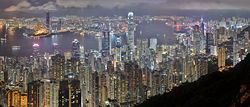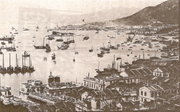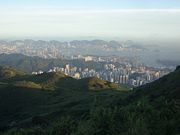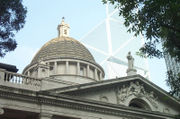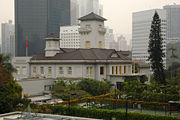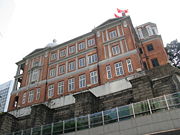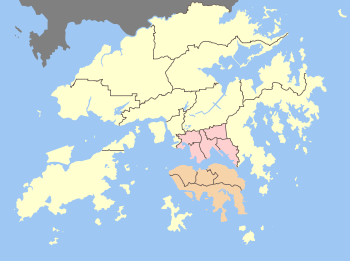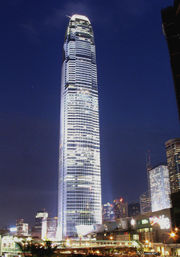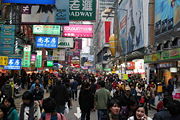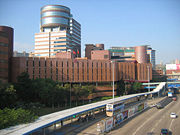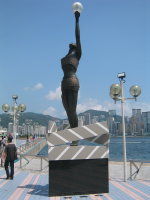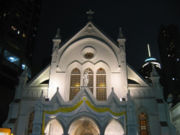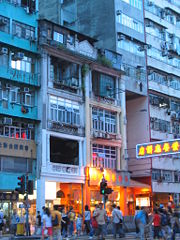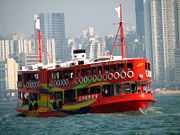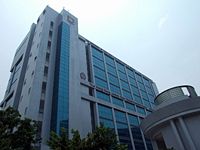Hong Kong
2008/9 Schools Wikipedia Selection. Related subjects: Asia; Asian Countries
| 香港特別行政區 Hong Kong Special Administrative Region
|
||||||
|---|---|---|---|---|---|---|
|
||||||
|
View at night from Victoria Peak
|
||||||
|
|
||||||
| Official languages | Chinese, English | |||||
| Demonym | Hongkonger | |||||
| Government | ||||||
| - | Chief Executive | Donald Tsang | ||||
| Establishment | ||||||
| - | Treaty of Nanking | 29 August 1842 | ||||
| - | Japanese occupation | 25 December 1941 – 15 August 1945 |
||||
| - | Transfer of sovereignty | 1 July 1997 | ||||
| Area | ||||||
| - | Total | 1,104 km² ( 183rd) 426 sq mi |
||||
| - | Water (%) | 4.6 | ||||
| Population | ||||||
| - | 2007 estimate | 6,963,100 ( 98th) | ||||
| - | 2001 census | 6,708,389 | ||||
| - | Density | 6,352/km² ( 3rd) 16,469/sq mi |
||||
| GDP ( PPP) | 2007 estimate | |||||
| - | Total | US$292.8 billion ( 38th) | ||||
| - | Per capita | US$41,994 ( 10th) | ||||
| GDP (nominal) | 2007 estimate | |||||
| - | Total | US$206.7 billion ( 37th) | ||||
| - | Per capita | US$29,650 ( 27th) | ||||
| Gini (2007) | 53.3 | |||||
| HDI (2007) | ▲ 0.937 (high) ( 21st) | |||||
| Currency | Hong Kong dollar ( HKD) |
|||||
| Time zone | HKT ( UTC+8) | |||||
| Internet TLD | .hk | |||||
| Calling code | +852 | |||||
Hong Kong Special Administrative Region, commonly known as Hong Kong (Chinese: 香 港 [ pronunciation]), is one of two special administrative regions in the People's Republic of China, the other being Macau. The territory lies on the eastern side of the Pearl River Delta, bordering Guangdong in the north and facing the South China Sea in the east, west and south.
Hong Kong was a dependent territory of the United Kingdom from 1842 until the transfer of its sovereignty to the People's Republic of China in 1997. The Sino-British Joint Declaration and the Basic Law of Hong Kong stipulate that Hong Kong operate with a high degree of autonomy until at least 2047, fifty years after the transfer. Under the “ one country, two systems” policy, the Central People's Government is responsible for the territory's defence and foreign affairs, while Hong Kong maintains its own legal system, police force, monetary system, customs policy, immigration policy, and delegates to international organisations and events.
Beginning as a trading port, Hong Kong emerged as a leading financial centre in the late 20th century. Its highly capitalist economy is heavily based on service industries, and thrives under a long-standing policy of government nonintervention. Although the population is predominantly Chinese, residents and expatriates of other ethnicities form a small but significant segment of society. Influenced by both Eastern and Western cultures, Hong Kong's unique formative experience is reflected in its cuisine, cinema and music.
History
Human settlement in the location now known as Hong Kong dates back to the Paleolithic era. The region was first incorporated into Imperial China in the Qin Dynasty, and served as a trading post and naval base during the Tang Dynasty and the Song Dynasty. The area's earliest recorded European visitor was Jorge Álvares, a Portuguese mariner who arrived in 1513.
In 1839 the refusal by Qing Dynasty authorities to import opium resulted in the First Opium War between China and Britain. Hong Kong Island was occupied by British forces in 1841, and then formally ceded to Britain under the Treaty of Nanking at the end of the war. The British established a Crown Colony with the founding of Victoria City the following year. In 1860, after China's defeat in the Second Opium War, the Kowloon Peninsula south of Boundary Street and Stonecutter's Island were ceded to Britain under the Convention of Peking. In 1898 Britain obtained a 99-year lease of Lantau Island and the adjacent northern lands, which became known as the New Territories.
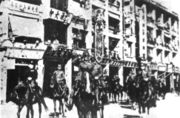
Hong Kong was declared a free port to serve as an entrepôt of the British Empire. The Kowloon-Canton Railway opened in 1910 with a southern terminus in Tsim Sha Tsui. An education system based on the British model was introduced. The local Chinese population had little contact with the European community of wealthy tai-pans settled near Victoria Peak.
In conjunction with its military campaign in World War II, the Empire of Japan invaded Hong Kong on December 8, 1941. The Battle of Hong Kong ended with British and Canadian defenders surrendering control of the colony to Japan on December 25. During the Japanese occupation, civilians suffered widespread food shortages, rationing, and hyper-inflation due to forced exchange of currency for military notes. Hong Kong lost more than half of its population in the period between the invasion and Japan's surrender in 1945, when the United Kingdom resumed control of the colony.
Hong Kong's population recovered quickly as a wave of mainland migrants arrived for refuge from the ongoing Chinese Civil War. With the proclamation of the People's Republic of China in 1949 more migrants fled to Hong Kong from fear of persecution by the Communist Party. Many corporations in Shanghai and Guangzhou also shifted their operations to Hong Kong. The colony became the sole place of contact between mainland China and the Western world, as the communist government increasingly isolated the country from outside influence. Trade with the mainland was interrupted during the Korean War, when the United Nations ordered a trade embargo against the communist government.
The textile and manufacturing industries grew with the help of population growth and low cost of labour. As Hong Kong rapidly industrialised, its economy became driven by exports to international markets. Living standards rose steadily with industrial growth. The construction of Shek Kip Mei Estate in 1953 marked the beginning of the public housing estate program. Hong Kong was disrupted by a year of chaos during the riots of 1967 following the commencement of the Cultural Revolution in 1966 in communist China.
The Independent Commission Against Corruption established in 1974 dramatically reduced corruption in the government. When the People's Republic of China initiated economic reforms in 1978, Hong Kong became the main source of foreign investments to the mainland. A Special Economic Zone was established the following year in the Chinese city of Shenzhen, located immediately north of the mainland's border with Hong Kong. Services gradually displaced textiles and manufacturing in the economy of Hong Kong, as the financial and banking sectors became increasingly dominant.
After the Vietnam War ended in 1975 the Hong Kong government spent 25 years dealing with the entry and repatriation of Vietnamese refugees.
With the lease of the New Territories due to expire within two decades the governments of the United Kingdom and the People's Republic of China discussed the issue of Hong Kong's sovereignty in the 1980s. In 1984 the two countries signed the Sino-British Joint Declaration, agreeing to transfer the sovereignty of Hong Kong to the People's Republic of China in 1997. The declaration stipulated that Hong Kong would be governed as a special administrative region, retaining its laws and a high degree of autonomy for at least fifty years after the transfer. Lacking confidence in the arrangement, some residents chose to emigrate, particularly after the Tiananmen Square protests of 1989.
The Basic Law of Hong Kong, which would serve as the constitutional document after the transfer, was ratified in 1990. Over strong objections from Beijing, Governor Chris Patten introduced democratic reforms to the election process for the Legislative Council. The transfer of the sovereignty occurred at midnight on July 1, 1997, marked by a handover ceremony at the Hong Kong Convention and Exhibition Centre. Tung Chee Hwa assumed office as the first Chief Executive of Hong Kong.
Hong Kong's economy was affected by the Asian financial crisis of 1997 that hit many East Asian markets. The lethal H5N1 avian influenza also surfaced that year. Implementation of the Airport Core Programme led to the opening of the new Hong Kong International Airport in 1998, after six years of construction. The project was part of the ambitious Port and Airport Development Strategy that was drafted in the early 1980s.
There was an outbreak of severe acute respiratory syndrome (SARS) in Hong Kong in the first half of 2003. That year half a million people participated in a march to voice disapproval of the Tung administration and the proposal to implement Article 23 of the Basic Law, which had raised concerns over infringements on civil liberties. The proposal was later abandoned by the administration. In 2005 Tung submitted his resignation as chief executive. Donald Tsang, the Chief Secretary for Administration, was selected as chief executive to complete the term.
Geography and climate
Hong Kong is located on China's south coast, 60 km (37 mi) east of Macau on the opposite side of the Pearl River Delta. It is surrounded by the South China Sea on the east, south, and west, and borders the city of Shenzhen in Guangdong Province to the north over the Sham Chun River. The territory consists primarily of Hong Kong Island, Lantau Island, Kowloon Peninsula and the New Territories as well as some 260 other islands. While Lantau is the largest island, Hong Kong Island is the second largest and the most populated. Ap Lei Chau is the most densely populated island in the world.
Much of Hong Kong remains undeveloped as the terrain is mostly hilly to mountainous with steep slopes. Of the territory's 1,104 square kilometres (426 sq mi), less than 25% is developed. The remaining land is remarkably green with about 40% of the landmass reserved as country parks and nature reserves. Most of the territory's urban development exists on Kowloon peninsula, along the northern shores of Hong Kong Island and in scattered settlements throughout the New Territories. The highest elevation in the territory is at Tai Mo Shan, at a height of 958 metres (3,140 ft) above sea level. Hong Kong's long, irregular and curvaceous coastline also affords the territory with many bays, rivers and beaches. Lowlands exist in the northwestern part of the New Territories.
Despite Hong Kong's reputation of being intensely urbanised, the territory has made much effort to promote a green environment, and recent growing public concern has prompted the severe restriction of further land reclamation from Hong Kong's most famous natural landmark, Victoria Harbour. Awareness of the environment is growing as Hong Kong suffers from increasing pollution compounded by its geography and tall buildings. Approximately 80% of the city's smog originates from other parts of the Pearl River Delta.
Situated just south of the Tropic of Cancer, Hong Kong's climate is subtropical ( Köppen climate classification Cwa), and is known for being unpredictable. Summer is hot and humid with occasional showers and thunderstorms, with warm air coming in from the southwest. It is also the time when tropical cyclones are most likely, sometimes resulting in flooding or landslips. Winter weather usually starts sunny and becomes cloudier towards February, with the occasional cold front bringing strong, cooling winds from the north. The most pleasant seasons are spring, although changeable, and autumn, which is generally sunny and dry. Hong Kong averages 1,948 hours of sunshine per year, while the highest and lowest ever recorded temperatures at the Hong Kong Observatory are 36.1 °C (97.0 °F) and 0.0 °C (32.0 °F), respectively. Frost occurs only once or twice a year inland and on higher ground, and snow is almost unheard of. Hong Kong does not observe daylight saving time.
| Weather averages for Hong Kong | |||||||||||||
|---|---|---|---|---|---|---|---|---|---|---|---|---|---|
| Month | Jan | Feb | Mar | Apr | May | Jun | Jul | Aug | Sep | Oct | Nov | Dec | Year |
| Average high °C (°F) | 18.6 (65) | 18.6 (65) | 21.5 (71) | 25.1 (77) | 28.4 (83) | 30.4 (87) | 31.3 (88) | 31.1 (88) | 30.2 (86) | 27.7 (82) | 24.0 (75) | 20.3 (69) | 25 (77) |
| Average low °C (°F) | 14.1 (57) | 14.4 (58) | 16.9 (62) | 20.6 (69) | 23.9 (75) | 26.1 (79) | 26.7 (80) | 26.4 (80) | 25.6 (78) | 23.4 (74) | 19.4 (67) | 15.7 (60) | 21 (70) |
| Precipitation mm (inches) | 24 (0.94) | 52 (2.05) | 71 (2.8) | 188 (7.4) | 329 (12.95) | 388 (15.28) | 374 (14.72) | 444 (17.48) | 287 (11.3) | 151 (5.94) | 35 (1.38) | 34 (1.34) | 2,382 (93.78) |
| Source: Hong Kong Observatory 2008 | |||||||||||||
Politics and government
In accordance with the Sino-British Joint Declaration, and reflecting the policy known as " one country, two systems" by the People's Republic of China, Hong Kong enjoys autonomy as a special administrative region except in defence and foreign affairs. The declaration stipulates that the region maintain its capitalist economic system and guarantees the rights and freedoms of its people for at least 50 years beyond the transfer of sovereignty. The Basic Law is the constitutional document that outlines executive, legislative and judicial authorities of government.
The Chief Executive is the head of government and the region's principal representative, chosen by the Election Committee to serve no more than two five-year terms. The 800 members of the Election Committee serve five-year terms, and are composed of ex-official government members and functional constituency delegates selected by qualified individuals and legal entities belonging to various industrial, commercial, professional, labour, social services, academic and religious sectors of society. The candidate chosen by the Election Committee must receive appointment by the Central People's Government to assume office. The Chief Executive appoints senior officers under the Principal Officials Accountability System and directs government policies with consultation from the Executive Council, the cabinet body. In addition, the Chief Executive appoints judges, signs legislation and may pardon or commute sentences.
The Legislative Council is the unicameral lawmaking body with 60 members serving four-year terms. Half of its membership is directly elected from geographical electoral districts by universal suffrage through a party-list proportional representation system, while the remaining half are returned from functional constituencies. The President of the Legislative Council is elected by and from among the members, and serves the role of speaker. Government bills are passed by a simple majority vote from members of the council, while private member's bills require separate majorities from geographical constituency members and functional constituency members for passage.
The Hong Kong Civil Service is a politically-neutral body that implements policies and provides government services. The appointment and promotion of public servants is based on qualifications, experience and ability. The permanent secretary is the most senior civil service position within each government bureau, serving under the politically-appointed position of secretary. The twelve bureaus operate from government office buildings located throughout the territory, with headquarters in the Central Government Offices.
The Basic Law and universal suffrage have been major issues of political debate since the transfer of sovereignty. In 2002, the government attempted to implement Article 23 of the Basic Law, which requires the enactment of laws prohibiting acts of treason and subversion against the Chinese government. The proposal met strong opposition due to concerns that it undermined civil liberties, and was a major cause for the July 1 march in 2003. The bill was shelved after it became clear it lacked the needed support in the legislature. Debate also surrounds the issue of reforming the electoral system for the Chief Executive and the Legislative Council, and the time frame for such political reforms. The Basic Law states that the ultimate aim is the election of the Chief Executive and the entire membership of the legislature by universal suffrage. The politics of Hong Kong is often characterised by the debate between pro-government groups and pro-democracy groups, which generally support a faster pace of democratisation. A proposal for political reform was defeated in the legislature in 2005.
Legal system and judiciary
In contrast to mainland China's civil law system, Hong Kong continues to follow the common law tradition established by British colonial rule. Article 84 of the Basic Law of Hong Kong allows Hong Kong's courts to refer to decisions ( precedents) rendered by courts of other common law jurisdictions. Articles 82 and 92 allow judges from other common law jurisdictions to participate in proceedings of Hong Kong's Court of Final Appeal and sit as Hong Kong judges.
Structurally, Hong Kong's court system consists of the Court of Final Appeal which replaced the Judicial Committee of the Privy Council, the High Court, which is made up of the Court of Appeal and the Court of First Instance, and the District Court, which includes the Family Court. Other adjudicative bodies include the Lands Tribunal, the Magistrates' Courts, the Juvenile Court, the Coroner's Court, the Labour Tribunal, the Small Claims Tribunal, and the Obscene Articles Tribunal, which is responsible for classifying non-video pornography to be circulated in Hong Kong. Justices of the Court of Final Appeal are appointed by Hong Kong's Chief Executive. The Basic Law of Hong Kong is subject to interpretation by the Standing Committee of the National People's Congress (NPC:SC) and this power has been invoked three times: the right of abode issue, an interpretation regarding post-2008 election procedures, and an interpretation regarding the length of the term of the Chief Executive.
As in England, lawyers in Hong Kong are classified as either barristers or solicitors, where one can choose to practice as either one but not both (but it is possible to switch from one to another.) The vast majority of lawyers are solicitors, who are licensed and regulated by the Law Society of Hong Kong. Barristers, on the other hand, are licensed and regulated by the Hong Kong Bar Association. Only barristers are allowed to appear in the Court of Final Appeal and the High Court. Just as the common law system is maintained, so are British courtroom customs such as the wearing of robes and wigs by both judges and lawyers.
According to the Article 63 of the Basic Law of Hong Kong, the Department of Justice controls criminal prosecutions, free from interference. It is the largest legal institution in Hong Kong, and its responsibilities involve legislation, judicial administration, prosecution, civil representation, legal and policy drafting and reform, and the legal profession. Aside from prosecuting criminal cases in Hong Kong, officials of the Department of Justice also appear in court on behalf of the government in all civil and administrative lawsuits against the government. As the protector of public interests, it may apply for judicial reviews and assign legal representation on behalf of public interest to take part in the trial of cases that involve material public interests.
Administrative districts
Hong Kong is subdivided into 18 geographic districts for administrative purposes:
|
|
|
|
||
Each district is represented by a District Council that advises the Government of Hong Kong on local matters such as public facilities, community programmes, cultural activities and environmental improvements. The Home Affairs Department is the governmental body responsible for coordinating services and communicating government policies and plans to the public. It interacts with the public at the local level through corresponding district offices.
As the territory is governed by unitary authority, there are no formal definitions for cities and towns in Hong Kong and no capital city has been designated. The historic boundaries of Victoria City, Kowloon and New Kowloon remain stated in law, but these entities have not had any legal or administrative status since the implementation of the District Administration Scheme in 1982. Previously some colonial-era texts had considered Victoria City to be the capital.
Economy
Hong Kong is one of the world's leading financial centres. Its highly capitalist economy, built on a policy of free markets, low taxation and government non-intervention, has been ranked as the most free economy in the world in the Index of Economic Freedom for 14 consecutive years. It is an important centre for international finance and trade, with the greatest concentration of corporate headquarters in the Asia-Pacific region, and is known as one of the Four Asian Tigers for its high growth rates and rapid industrialisation between the 1960s and 1990s. The Hong Kong Stock Exchange is the sixth largest in the world, with a market capitalisation of US$2.97 trillion as of October 2007, and the second highest value of initial public offerings, after London. The currency used in Hong Kong is the Hong Kong dollar, which has been pegged to the US dollar since 1983.
Continuing the practice established under the British administration, the Government of Hong Kong generally plays a passive role in the financial industry, mostly leaving the direction of the economy to market forces and the private sector. Under the official policy of positive non-interventionism, Hong Kong has often been cited as a prime example of laissez-faire capitalism. Following the Second World War, Hong Kong industrialised rapidly as a manufacturing centre driven by exports, and then underwent a rapid transition to a service-based economy in the 1980s. Hong Kong matured to become a financial centre in the 1990s, but was greatly affected by the Asian financial crisis in 1998, and again in 2003 by the SARS outbreak. A revival of external and domestic demand led to a strong recovery the following year, as cost decreases strengthened the competitiveness of Hong Kong exports, and a 68-month-long deflationary period ended, with consumer price inflation close to zero.
Hong Kong has little arable land and few natural resources within its borders, and must therefore import most of its food and raw materials. Hong Kong is the world's eleventh largest trading entity, with the total value of imports and exports exceeding its gross domestic product. Much of Hong Kong's exports consist of re-exports, which are products made outside of the territory, especially in mainland China, and distributed via Hong Kong. Even before the transfer of sovereignty to the People's Republic of China, Hong Kong had established extensive trade and investment ties with mainland China. The territory's autonomous status enables it to serve as a point of entry for investments and resources flowing into the mainland. It is also a connecting point for flights from Taiwan destined for the mainland.
At the end of 2007, there were 3.46 million people employed full-time, with the unemployment rate averaging 4.1%, the fourth straight year of decline. Hong Kong's economy is dominated by the service sector, which accounts for over 90% of its GDP, while industry now constitutes just 9%. Hong Kong's tourism industry has recently benefitted from an increase in mainland visitors and the opening of Hong Kong Disneyland Resort in 2005. Inflation was at 2% in 2007, and Hong's Kong's largest export markets are China, the United States, and Japan.
Demographics
Residents of Hong Kong are sometimes referred to as Hongkongers. Hong Kong's population increased sharply throughout the 1990s, reaching 6.99 million in 2006. About 95% of Hong Kong's population is of Chinese descent, the majority of which is Cantonese or from ethnic groups such as Hakka and Teochew. Cantonese, a Chinese language originating from Guangdong province to the north of Hong Kong, is Hong Kong's de-facto official dialect and 95% of the population speaks Cantonese as their first language. English is also an official language widely spoken by more than 38% of the population. According to the 1996 Hong Kong Government by-census, some 3.1% regard English as their 'usual' language with 34.9% claiming to speak English as 'another' language. Signs displaying both Chinese and English are common throughout the territory. Since the 1997 handover, new groups of mainland Chinese immigrants have arrived. The usage of Mandarin, the official dialect of People's Republic of China and Republic of China (Taiwan), has also increased. The integration with mainland economy led to a demand in Mandarin speakers.
The remaining 5% of the population is composed of non-ethnic Chinese forming a highly visible group despite their smaller numbers. A South Asian population of Sindhis, Indians, Pakistanis and Nepalese are found. Vietnamese refugees have become permanent residents. Approximately 140,000 Filipinos live and work in Hong Kong with the majority as foreign domestic helpers. An increasing number of domestic workers also originate from Indonesia. There are also a number of Europeans, Americans, Australians, Canadians, Japanese, and Koreans working in Hong Kong's commercial and financial sector.
Considered as a dependency, Hong Kong is one of the most densely populated countries/dependencies in the world, with an overall density of more than 6,200 people per km². Hong Kong has a fertility rate of 0.95 children per woman, one of the lowest in the world and far below the 2.1 children per woman required to sustain the current population. However, population in Hong Kong continues to grow due to the influx of immigrants from mainland China approximating 45,000 per year. Life expectancy in Hong Kong is 81.6 years as of 2006, 2nd highest in the world.
Hong Kong's population has an extremely dense urban core, consisting of Kowloon and the north of Hong Kong Island. The rest of Hong Kong is relatively sparsely populated, with millions of residents scattered irregularly throughout the New Territories, south Hong Kong island and Lantau Island. An increasing number of citizens are commuting from Shenzhen in mainland China.
Education
A former Crown colony, Hong Kong's education system has roughly followed the system of the United Kingdom, and in particular, the education system in England. At the higher education levels, both British and American systems exist. The University of Hong Kong (HKU), the oldest institution of tertiary education in Hong Kong, has traditionally been based on the British model but has incorporated elements of the American model in recent years. The second oldest university, Chinese University of Hong Kong (CUHK), follows the American model with a characteristically British college system. The Hong Kong University of Science and Technology (HKUST) was established on the American model of higher education. There are nine public universities in Hong Kong, and a number of private higher institutions.
Hong Kong's public schools are operated by the Education Bureau. The system features a non-compulsory three-year kindergarten, followed by a compulsory six-year primary education, three-year junior secondary education; a non-compulsory two-year senior secondary education leading to the Hong Kong Certificate of Education Examinations and a two-year matriculation course leading to the Hong Kong Advanced Level Examinations. A new "3+3+4" curriculum, consisting of a three-year junior secondary, three-year senior secondary and four-year undergraduate academic system, will be implemented from 2009 (for senior secondary) and 2012 (for tertiary) onwards. There are also tertiary institutions offering various Bachelor's, Master's, and Doctoral degrees, other higher diplomas and associate degree courses.
Most comprehensive schools in Hong Kong fall under three categories: Public schools, subsidised schools and private schools. Public schools are rare, and subsidised schools are the most common, which include government aids and grant schools, run by charitable organisations often with religious affiliations. The majority of such religious affiliations are Christian, but there are also Buddhist, Daoist (Taoist), Islamic and Confucian ones as well. Meanwhile, private schools, often run by Christian organisations, have admissions based on academic merit rather than on financial resources. Outside this system are the schools under the Direct Subsidy Scheme (DSS) and private international schools. The medium of instruction is mainly spoken Cantonese, written Chinese and English.
The Programme for International Student Assessment, coordinated by the OECD, currently ranks Hong Kong's education as the 2nd best in the world.
Culture
Hong Kong is frequently described as a place where East meets West, a meeting reflected in its inhabitants, their customs, economic infrastructure, education and culture. British rule may have ended in 1997 but Western culture is deeply ingrained in Hong Kong and coexists seamlessly with traditional philosophy and practices of the Chinese. On one street corner, there may be traditional Chinese shops selling Chinese herbal medicine, Buddhist paraphernalia or bowls of synthetic shark fin soup, but around the next, one may find theatres showing the latest Hollywood blockbuster, an English-style pub, or a Catholic Church. Hong Kong's official languages are Cantonese and English; signs in both languages are omnipresent throughout Hong Kong. The government, police and most workplaces and stores conduct business bilingually.
While Hong Kong is a global centre of trade, another famous export is its entertainment industry, particularly in the martial arts genre which gained a high level of popularity in the late 1960s and 1970s. Several Hollywood performers originate from Hong Kong cinema, notably Bruce Lee, Chow Yun-Fat, and Jackie Chan. A number of Hong Kong filmmakers have also achieved widespread fame in Hollywood, such as John Woo, Wong Kar-wai and Tsui Hark. Homegrown films such as Chungking Express, Infernal Affairs, Shaolin Soccer, Rumble in the Bronx, Eros and In the Mood for Love have also gained international recognition. Hong Kong is also the world's main hub for Cantopop music and is home to the first fulltime comedy club in Asia, The TakeOut Comedy Club Hong Kong.
The Hong Kong government also supports cultural institutions such as the Hong Kong Heritage Museum, Hong Kong Museum of Art, the Hong Kong Academy for Performing Arts and the Hong Kong Philharmonic Orchestra. Furthermore, the government's Leisure and Cultural Services Department also subsidises and sponsors international performers brought to Hong Kong. Many international cultural activities are organised by the government, consulates and privately.
Religion
Hong Kong enjoys a high degree of religious freedom, a right enshrined and protected through its constitutional document, the Basic Law. The majority of Hong Kong's population (90%) practise a mix of local religions, Buddhism (mainly Chinese Mahayana) alongside with Taoism. Buddhists and Taoists share a common background of Confucian theory, Chinese folk religion (worship of folk deities and figures of Chinese mythology) and ancestor worship.
A sizable Christian community of around 560,000 local adherents (320 thousand Protestant Christians, 240 thousand Roman Catholics) to 660,000 exists (if including over 100 thousand Filipino Catholics), forming about 8% to 9% of the total population; it is roughly equally divided between Catholics and Protestants. Apart from the major religions, there are also a significant number of followers of other religions, including an estimated 90,000 Muslims; 22,000 members of The Church of Jesus Christ of Latter-day Saints; 4,000 Jews; 4,600 Jehovah's Witnesses and a number of Hindus, Sikhs and Bahá'ís. Apart from offering religious instructions, many major religious bodies have established schools and provided social welfare facilities.
Hong Kong's religious beliefs are tied to the region's early role as a fishing community. Tin Hau, the protector of seafarers, has been honoured with several temples throughout Hong Kong for at least 300 years. Hong Kong residents, especially elder generations, visit Taoist or Buddhist temples to appease the deities and, usually, to request compassion, good health or good fortune. Gifts of food, and in particular fruit, are presented, and incense and paper offerings are burnt in respect.
With the transfer of Hong Kong to the PRC, there were significant concerns over religious freedom in Hong Kong. So far, this has proved mostly unfounded. Despite the banning of the Falun Gong movement by Beijing in 1999, adherents are still free to practice in Hong Kong. Similarly, the Catholic Church freely appoints its own bishops in Hong Kong, unlike on mainland China where the only approved 'Catholic' institution is the Chinese Patriotic Catholic Association where bishops and priests are appointed by Beijing (though there is also an unofficial and illegal part of the Catholic church that maintains contact with the Vatican). A significant issue in the normalisation of ties between the PRC and the Vatican is Beijing's insistence that the Vatican drops its diplomatic ties with the ROC.
Architecture
At present, Hong Kong has the world's greatest number of skyscrapers, with a total of 7,688, well ahead of the second place city, New York City, which has 5,640. Most of these were built in the past two decades.
Due to the lack of available space, few historical buildings remain in Hong Kong as older buildings are regularly torn down to make way for new developments. Instead, the city has become a centre for modern architecture, especially in and around Central. Dense commercial skyscrapers line the coast of Victoria Harbour from Central to Causeway Bay, and Hong Kong's skyline, ranked the best skyline in the world, is a major tourist attraction. Four of the 18 tallest skyscrapers in the world are in Hong Kong. In Kowloon, which once included the nihilistic settlement called the Kowloon Walled City, the proximity of Kai Tak Airport previously necessitated strict height limits for all buildings. With the closure of Kai Tak Airport in 1998, these restrictions were lifted and several new skyscrapers in Kowloon are now under construction, including International Commerce Centre which, when completed in 2010, will become the world's fourth tallest.
One of the notable buildings in Hong Kong is I. M. Pei's Bank of China Tower, completed in 1990 and now the city's third tallest skyscraper. This building generated heated controversy from the start, as its sharp angles were said to cast negative feng shui energy into the heart of Hong Kong. Predating the Bank of China Tower, another well-known structure is the HSBC Headquarters Building, finished in 1985. It was built on the site of Hong Kong's first skyscraper, which was finished in 1935 and was the subject of a bitter heritage conservation struggle in the late 1970s. Both banks' buildings are featured on many of Hong Kong's banknotes.
The tallest building in Hong Kong is currently the Two International Finance Centre. Other well-known projects in Hong Kong include the new Hong Kong International Airport on Chek Lap Kok near Lantau, a huge land reclamation project linked to the centre of Hong Kong by the Lantau Link, which features three new major bridges: Tsing Ma, the world's sixth largest suspension bridge; Kap Shui Mun, the world's longest cable-stayed bridge carrying both road and railway traffic; and Ting Kau, the world's first major four-span cable-stayed bridge.
Transport
Hong Kong has a highly developed transportation network, encompassing both public and private transport. Over 90% of daily travels (11 million) are on public transport, making it the highest percentage in the world. The Octopus card stored value smart card payment system can be used to pay for fares on almost all railways, buses and ferries in Hong Kong. The Octopus card uses RFID (Radio Frequency Identification) to allow users to scan their card without taking it out of their wallet or bag. All parking meters in Hong Kong accept payment by Octopus card only, and Octopus card payment can be made at various car parks. Unlike the rest of the People's Republic of China, Hongkongers drive on the left side of the road.
Seeing wide usage is the city's metro system, MTR, both an underground rail system and a link between Hong Kong and mainland China. It has 150 stations and moves 3.4 million people a day. The tramway system, serving the city since 1904, covers the northern parts of Hong Kong Island and is the only tram system in the world run exclusively with double deckers. There are five operators running franchised public bus services in Hong Kong. Double-decker buses were introduced to Hong Kong in 1949, and are now almost exclusively used, with single-decker buses remaining in use for routes with lower demand or roads with lower carrying capacity. Most normal franchised bus routes in Hong Kong operate until 1 am. Public light buses run the length and breadth of Hong Kong, through areas where standard bus lines cannot reach or do not reach as frequently, quickly, or directly.
The Star Ferry service operates four lines across Victoria Harbour and has been in operation for over 120 years, providing a panoramic view of Hong Kong's skyline for its 53,000 daily passengers. It is considered one of the city's most treasured cultural icons and has been rated as one of the most picturesque ferry crossings in the world. Other ferry services are provided by operators serving outlying islands, new towns, Macau, and cities in mainland China. Hong Kong is also famous for its junks traversing the harbour, and small kai-to ferries which serve remote coastal settlements.
As Hong Kong is dominated by steep, hilly terrain, some unusual methods of transport have been devised to ease movement up and down the slopes. For example, the Peak Tram, the first public transport system in Hong Kong, has provided vertical rail transport between Central and Victoria Peak since 1888 by steeply ascending the side of a mountain. In Central and Western district, there is an extensive system of escalators and moving pavements, including the longest outdoor covered escalator system in the world, the Mid-Levels escalator.
Hong Kong International Airport is a leading air passenger gateway and logistics hub in Asia and one of the world's busiest airports in terms of international passenger and cargo movement, serving more than 47 million passengers and handling 3.74 million tonnes of cargo in 2007. It replaced Kai Tak Airport in Kowloon in 1998 and has been voted the world's best airport multiple times. Over 85 airlines operate at the two- terminal airport and it is the primary hub of Cathay Pacific, Dragonair, Air Hong Kong, Hong Kong Airlines and Hong Kong Express.
Taxis are widely used throughout Hong Kong, all of which are obliged by law to run on liquefied petroleum gas instead of diesel, in order to help the city's pollution problems. Despite the effort, the level of smog and pollution in Hong Kong is very high.
Healthcare
Hong Kong's medical infrastructure consists of a mixed medical economy, with 12 private hospitals and more than 50 public hospitals. There are also polyclinics that offer primary care services, including dentistry. Hong Kong has two medical schools, one with the University of Hong Kong (the Li Ka Shing Faculty of Medicine) and the other with the Chinese University of Hong Kong. Medical graduates obtain the MBChB or MBBS, based upon the British model. There are also schools of nursing, both public and private, and training for professions allied to medicine, including a school dedicated to dentistry. The Hospital Authority is a statutory body established on 1 December 1990 under the Hospital Authority Ordinance to manage all 38 public hospitals and institutions in Hong Kong. It is mainly responsible for delivering a comprehensive range of secondary and tertiary specialist care and medical rehabilitation through its network of health care facilities. The Authority also provides some primary medical services in 74 primary care clinics.
Hong Kong's 12 private hospitals have partnered with the United Kingdom for international healthcare accreditation. All 12 private hospitals are "Trent Hospitals", having been surveyed and accredited by the United Kingdom's Trent Accreditation Scheme. The Hong Kong Academy of Medicine is an independent institution with the statutory power to organise, monitor, assess and accredit all medical specialist training and to oversee the provision of continuing medical education in Hong Kong. In addition, The Royal College of Physicians and Surgeons of Canada has also accredited the postgraduate medical education (1994-present) in Hong Kong and allowed these graduates from the Hong Kong Academy of Medicine seeking RCPSC Certification and practising in Canada.
The Department of Health, under Food and Health Bureau, is the health adviser of Hong Kong government and an executive arm in health legislation and policy. Its main role is to safeguard the health of the community through promotive, preventive, curative and rehabilitative services in Hong Kong. The main function of the department includes child assessment service, immunisation programmes, dental service, forensic pathology service, registration of healthcare professionals etc, though boards and councils (i.e. Medical Council of Hong Kong, Pharmacy and Poisons Board of Hong Kong) are independent statutory bodies established under the relevant ordinances that operate independently to discharge their statutory functions.
Hong Kong is one of the healthiest places in the world. Because of its early health education, professional health services, and well-developed health care and medication system, Hongkongers enjoy a life expectancy of 84 for females and 78 for men, which are the second highest in the world, and 2.94 infant mortality rate, the fourth lowest in the world.
Hong Kong has high standards of medical practice. It has contributed to the development of liver transplantation, being the first in the world to carry out adult to adult live donor liver transplant in 1993.
Military
During British administration, the Governor of Hong Kong was the Commander-in-Chief and Vice-Admiral, defence force was provided by the British military, who stationed soldiers in barracks throughout Hong Kong, including the British Forces Overseas Hong Kong. Its finance was supported by both the UK Government and the Hong Kong Government. Hong Kong has never had its own military forces because it has never been a sovereign state, except voluntary auxiliary forces like The Royal Hong Kong Regiment (The Volunteers).
The People's Republic of China's State Council assumed sovereignty over Hong Kong on 1 July 1997 and stationed a garrison of the People's Liberation Army (PLA) to manage its defence affairs. Although the garrison has little practical military value, the stationing of the PLA troops in Hong Kong is a significant symbol of the PRC government's assumption of sovereignty over Hong Kong.
According to Hong Kong's Basic Law, military forces stationed in Hong Kong will not interfere with local civil affairs; the Hong Kong SAR Government remains responsible for the maintenance of public order. The Hong Kong Garrison, composed of ground, naval, and air forces, is under the command of the Chinese Central Military Commission. The PLA Garrison subsequently opened its barracks on Stonecutters Island and Stanley to the public to promote understanding and trust between the troops and residents.


